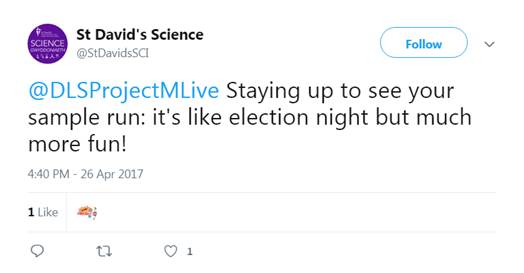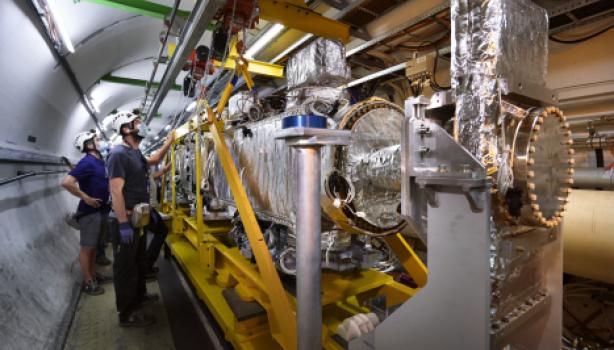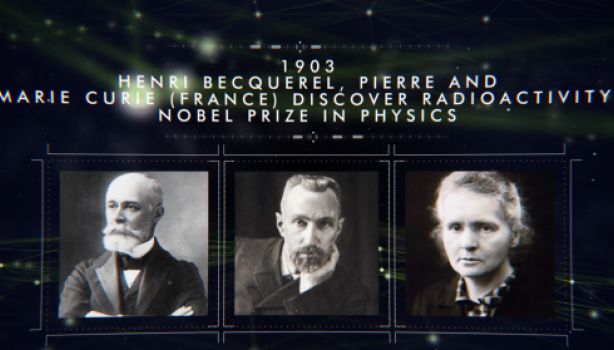Header Image: Project M kit send to participating schools. (Image: Project M)
In April 2017, over 800 samples of calcium carbonate were analysed in 24 hours on the High Resolution Powder Diffraction beamline (I11) at Diamond Light Source, the UK’s national synchrotron. The samples contained different forms of calcium carbonate, obtained in the presence of different concentrations of amino acids. These concentrations affect the type of calcium carbonate that forms, (called a ‘polymorph’) and thus its proprieties and potential applications. A systematic study of this scale had never before been completed at Diamond, or anywhere else in the world.
In order to analyse so many samples, it was critical to make use of the I11 robot, which meant the team could collect a dataset and change sample in less than 90 seconds. However, the time necessary to prepare these samples remained the same, so to do such a large-scale study of calcium carbonate polymorphs, it was necessary to gather more researchers to prepare the samples.
Project M: Research-led student science at Diamond Light Source
This is how Project M – where M is the roman numeral for 1000 – came to be. Project M invited 100 UK schools to prepare 10 calcium carbonate samples, using different additive solutions. Given that this was a real experiment, there were samples that didn’t work or schools that didn’t have time to make their samples. However, all samples made were analysed at Diamond on 26 April 2017, in a 24-hour period. “The project was led by a scientific question we had,” explained Claire Murray, a scientist working on beamline I11. “The idea to involve school students in the preparation of the samples came after.” The data were live-tweeted during collection on Twitter @DLSProjectMLive, to the excitement of the school teams.

Image 1. Tweet by one of the participating schools. (Image: Project M)
Project M enabled schools to carry out real research and do an experiment that had never been done before, in their own school laboratory. It was the first ‘citizen science’ project run by Diamond, facilitated by Claire, Senior Beamline Scientist Julia Parker, Engagement Manager Laura Holland, and a team of 20 colleagues. This research-led student science project transported Diamond science to schools, and enabled the production of a considerable set of results, later analysed by the students and by researchers at Diamond.
The science of Project M
The first part of the experiment was for the samples to be prepared by making solutions with chemicals provided to schools by Diamond, and then filtering the precipitate. The students then had the task of loading a capillary (with a 0.5 mm cavity) that would be used for analysis at the beamline - a task that is not easy even for highly-educated and highly-skilled researchers! All these materials were included in the experiment kits sent to the schools.
After analysis at Diamond, the students had the opportunity to look at their results, see their peaks and determine what sort of polymorphs they had produced, and compare their results with the results obtained by different samples and different schools at different locations in the UK.
“The fact that we didn’t know the answer yet was a motivational factor for the students,” explains Claire. “The teachers told us they took everything more seriously, because this was real science in action – it really meant something.”
Science in the classroom
Performing real science experiments in the classroom motivated both students and teachers. “The pupils loved taking part and enjoyed feeling the ‘real life aspect’ of Chemistry. The experiment did take longer than expected but the pupils did not mind at all,” said Rebeca, one of the teachers at St. Teilios. The feedback was almost the same for all the schools involved.
Project M is one of many projects that bring accelerator science into the classroom: in the UK, The Institute for Research in Schools (IRIS) partners with CERN for the CERN@School programme, through which students carry out their research projects using detectors provided by IRIS.
Due to its relevance and impact, the Royal Society of Chemistry awarded its Inspiration & Industry Award for 2018 to Project M. The award recognises the originality and impact in chemistry education, among other areas. “We were incredibly excited to accept this award,” said Claire. “We were so impressed with how much [the students] engaged with the research and with the project. We hoped that the project will show students that being a scientist is for everyone.”
The award also acknowledges the importance of teamwork across the chemical sciences, and teamwork was something that defined the success of Project M. All the aspects that needed to be considered – class length, transporting chemicals through the post, access to the results, the production of teaching materials and experiment protocols – implied a large array of the expertise that can be found at Diamond. “From developing new software to packing the kits, we were helped in so many ways by a huge number of people, whose support was invaluable,” added Claire.
These results obtained by Project M will feature in a scientific publication that Claire, Julia and Laura are currently preparing. The research team are interested in finding out how different additives like amino acids affect the formation of calcium carbonate, a naturally occurring mineral. The mineral has three main polymorphs – vaterite, calcite and aragonite – identified through X-ray crystallography at beamline l11. Understanding the impact of different additives on the production of polymorphs is of huge interest in industry such as in manufacturing, medical applications such as tissue engineering and the design of drug-delivery systems, and even cosmetics.


